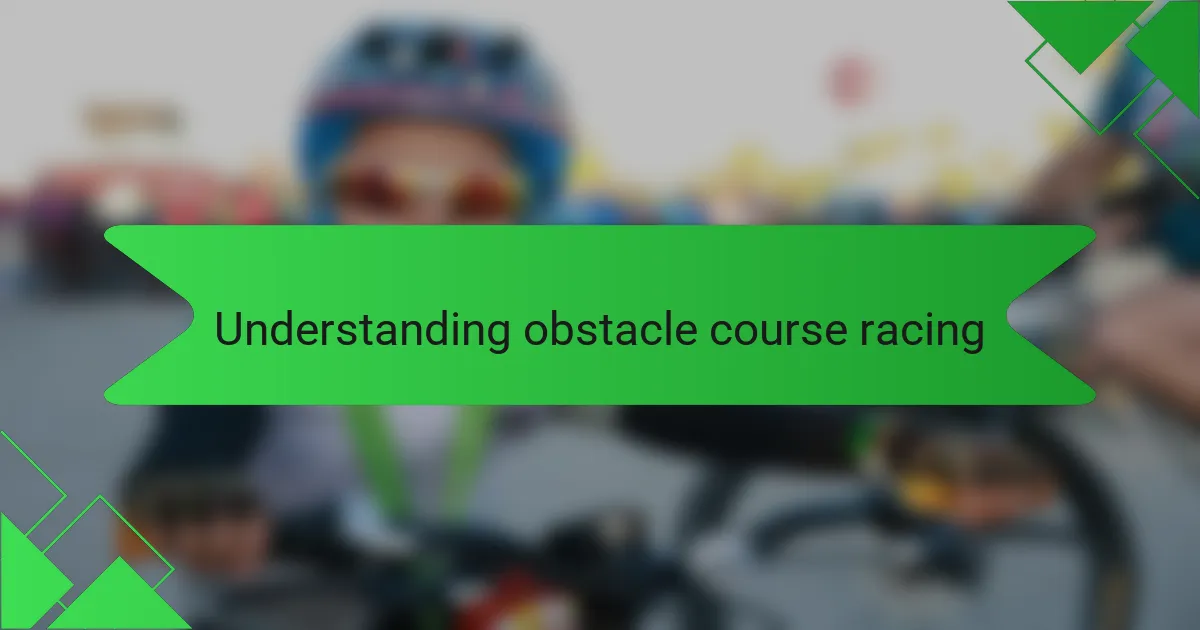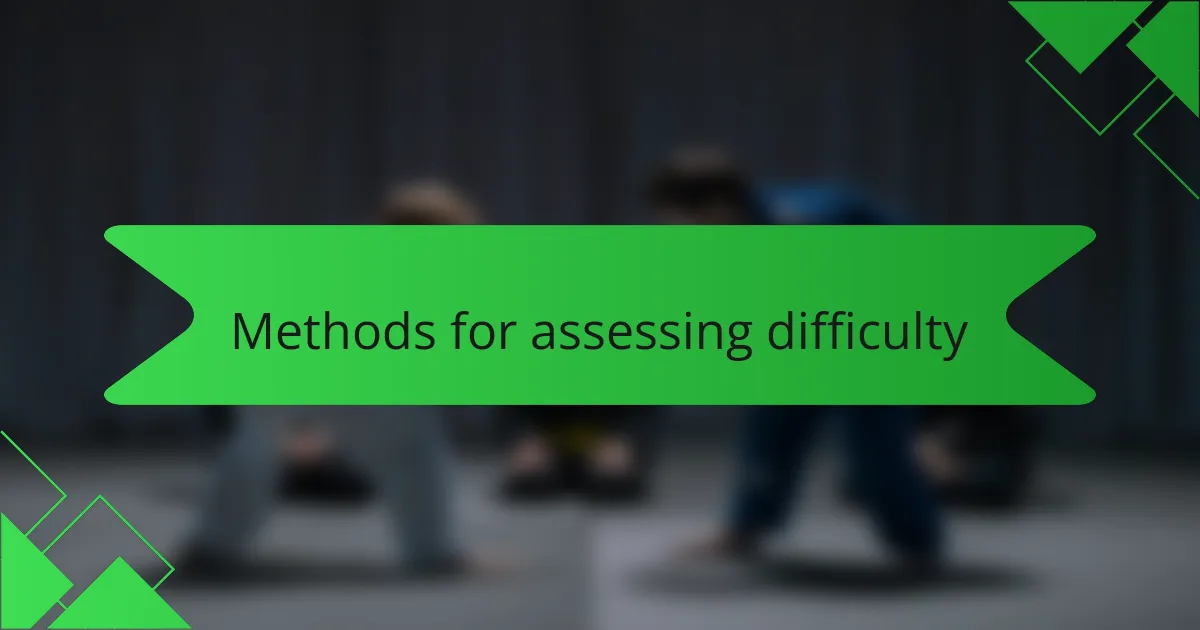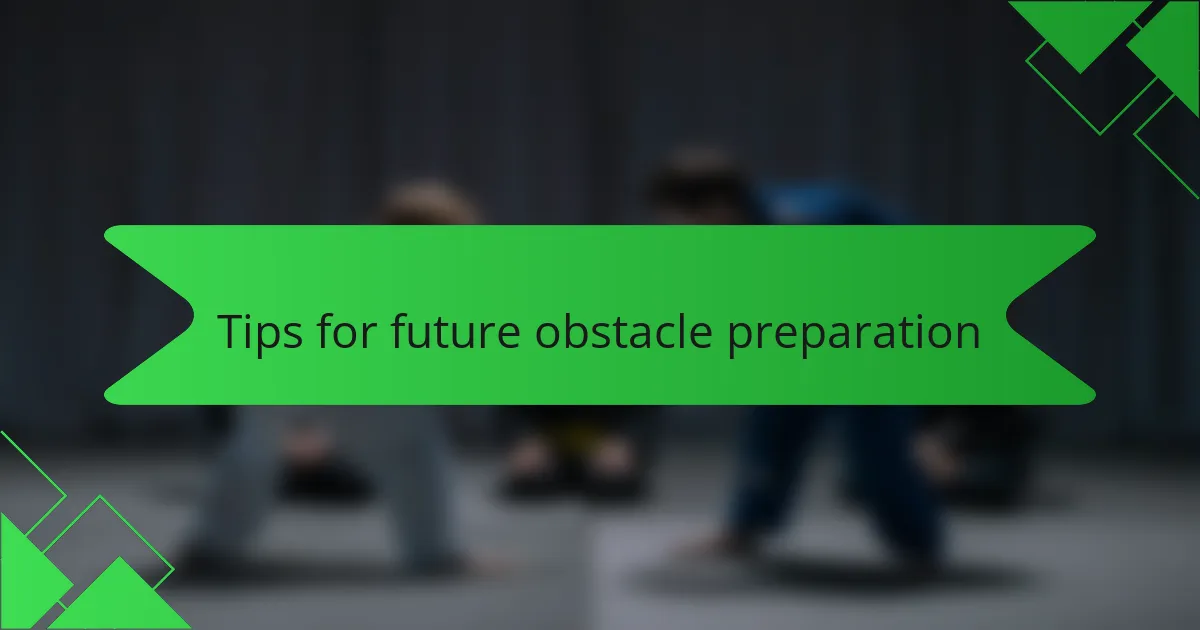Key takeaways
- Obstacle course racing combines physical strength with mental resilience, requiring strategy and adaptability.
- Challenges like Tough Mudder foster community and teamwork, making shared struggles pivotal to the experience.
- Evaluation of obstacles should consider physical demands, mental hurdles, and the importance of cooperation among participants.
- Effective preparation includes a mix of physical training and mental visualization, complemented by teamwork exercises.

Understanding obstacle course racing
Obstacle course racing is more than just running through mud and climbing walls; it’s a physical and mental test that pushes you beyond your comfort zone. Have you ever wondered what makes someone keep going when their muscles scream to stop? From my experience, it’s that mix of grit and determination that defines this sport.
When I first tackled an obstacle course, I underestimated how much strategy mattered. It’s not just about brute strength; timing your energy and adapting to each challenge is key. This blend of endurance, agility, and problem-solving keeps the race exciting and unpredictable.
What I find most captivating is how obstacle course racing builds community and self-confidence. Facing tough obstacles alongside fellow racers creates an unspoken bond. Have you felt that rush of accomplishment after conquering a seemingly impossible task? That moment alone makes every scraped knee worth it.

Overview of Tough Mudder challenges
Tough Mudder challenges are designed to test more than just your physical limits—they demand mental toughness and teamwork. I remember facing the infamous Arctic Enema, where plunging into icy water felt like a shock to my very core; it wasn’t just about freezing but overcoming the intense urge to quit. Have you ever been pushed to the edge and surprised yourself by pushing back harder?
What stands out to me about these challenges is how varied they are. From electric shocks to high walls and muddy crawls, no two obstacles are alike. This variety keeps your mind engaged and your body guessing, making every step a new puzzle to solve rather than just a repetitive grind.
For me, the real challenge lies in the camaraderie these obstacles create. When you’re stuck halfway up a wall or navigating a slippery slope, it’s the helping hands and shared grit that make all the difference. Isn’t it remarkable how strangers become teammates, united by the struggle and triumph of each tough Mudder challenge?

Criteria for obstacle evaluation
When I evaluate Tough Mudder obstacles, I focus first on their physical demands. How much strength, balance, or endurance does it take to complete the challenge? For instance, when I tackled the “Everest” wall, the required explosive power made me appreciate how these obstacles test pure physical capability.
Next, I consider the mental aspect — does the obstacle intimidate you or force you to face a fear? I vividly recall the “Electroshock Therapy” section; it was as much about resisting panic as it was about powering through uncomfortable shocks. That mental battle often defines the obstacle more than the actual movement.
Finally, I evaluate the teamwork element. Does this obstacle encourage helping others or push you into solitary struggle? Tough Mudder’s design often fosters camaraderie, and I’ve found that some obstacles become memorable precisely because of the support shared in those moments. Have you noticed how a simple hand extended at the right time can transform an obstacle into a highlight?

Methods for assessing difficulty
Assessing the difficulty of Tough Mudder obstacles often starts with breaking down what each one demands physically. I remember sizing up “Funky Monkey” and realizing how much grip strength and coordination it required, which gave me immediate insight into how challenging it would be before even attempting it. Don’t you find that a quick mental checklist helps you prepare better?
Beyond muscles and endurance, I’ve learned to gauge difficulty by tuning into the mental hurdles an obstacle poses. For example, “Kong” looked intimidating not just because of its height but because it triggered that primal fear of falling, making me question if I was ready to face it head-on. This mental assessment, I believe, is what separates an obstacle from a mere physical barrier.
Sometimes, the toughest part isn’t the obstacle itself but the dynamic it creates between racers. When I faced “Arctic Enema,” the chilling water was brutal, yet what struck me was noticing how much easier it felt with others encouraging you through the shock. I often ask myself, how much does teamwork ease the burden or crank up the difficulty? It’s a factor that’s surprisingly easy to overlook but crucial in my evaluations.

Personal experience with Tough Mudder
Tackling my first Tough Mudder was nothing short of eye-opening. I remember standing at the edge of the “Electroshock Therapy” obstacle, my heart pounding not just from the anticipation but from that raw fear of the unknown. Have you ever felt that mix of dread and excitement before a challenge? For me, it was a defining moment that showed how much this race pushes you mentally.
One moment that truly stuck with me was the camaraderie during the “Walk the Plank” section. Struggling with the balance and the slippery surface, I was ready to give up until a fellow participant reached out, steadying me just when I needed it most. That unexpected support transformed a tough moment into a shared victory and reminded me why Tough Mudder is as much about teamwork as it is about personal grit.
Looking back, I realize how every obstacle tested not just my body but my mindset. I found myself constantly questioning, “Can I push a little further?” That inner dialogue, paired with the physical strain, created an experience that felt both exhausting and exhilarating—a true testament to why I keep coming back.

Lessons learned from obstacle evaluation
Evaluating Tough Mudder obstacles taught me that each challenge holds a lesson beyond just the physical. I realized that sometimes the biggest hurdle is mental—questioning whether you can really push through when your body is screaming to stop. Have you ever been surprised by your own resilience when facing something you thought was impossible?
Another insight I gained is how crucial adaptability is during the race. Not every obstacle demands the same approach, and learning when to conserve energy or ask for help made my experience less daunting and more rewarding. Isn’t it fascinating how a slight shift in mindset can change a struggle into an achievement?
Finally, the evaluation process highlighted how critical teamwork can be in overcoming obstacles. On more than one occasion, a simple act like a helping hand or a word of encouragement turned a near-failure into a moment of triumph. These moments stick with me, reminding me that obstacle racing is as much about connection as it is about individual grit.

Tips for future obstacle preparation
Preparing for future obstacles, I’ve learned, means training both your body and your mind. For example, before my last Tough Mudder, I focused on grip strength exercises and mental rehearsals, picturing myself conquering each challenge. Have you ever tried visualizing success to calm those pre-race jitters? It really made a difference in my confidence.
Another tip that’s become clear through experience is to embrace versatility in your workouts. I mix running, climbing, and balance drills because Tough Mudder obstacles demand all-around fitness. When I neglected this approach early on, I found myself struggling on tasks like “Funky Monkey,” which called for grip and coordination I hadn’t practiced enough.
Lastly, I can’t stress enough the value of practicing teamwork during your prep. Training with friends or joining group sessions helps build that shared trust and support you’ll rely on during the race. I remember in one event, a teammate’s encouragement got me through “Arctic Enema” when I was ready to quit—so, why not start building those bonds ahead of time?
